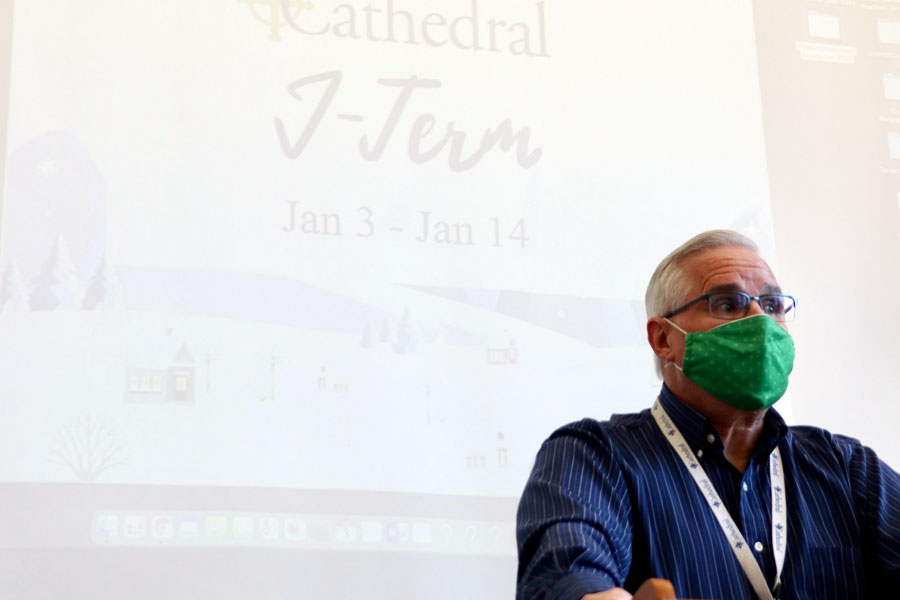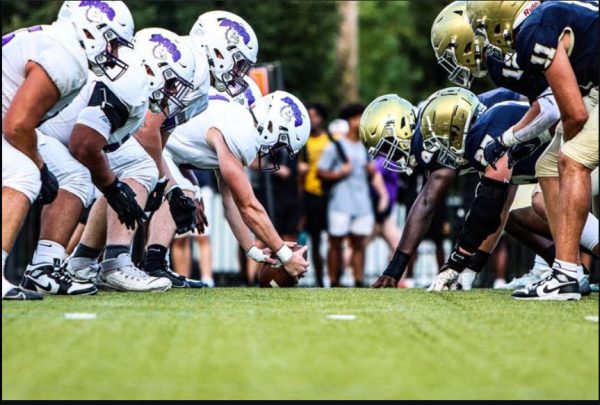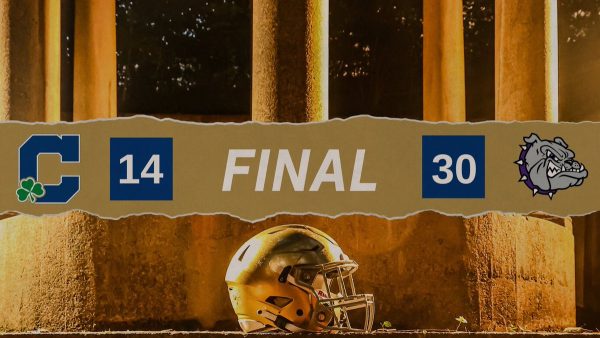School’s first J-Term is off to a good start
Vice principal notes the origin of the two-week event
On the first day of J-Term on Jan. 3, Vice Principal Mr. Matthews participated in a presser with the journalism class.
With the opening week of J-Term kicking off, students and teachers are able to experience diverse learning environments and opportunities.
Vice principal for academics Mr. Mark Matthews has been in education for 38 years and said that his first day of J-Term has “been hectic, but it’s been fun.”
The idea of J-Term originated in 2019 at a faculty meeting. Matthews said, “We were talking about ways to innovate as we were planning to create the Innovation Center. At first I think a lot of people’s ideas were STEM-focused with science, technology and mathematics. But when we began to really think about it, we realized that innovation is really just continually getting better.”
Once this realization came about, Matthews said that all of the faculty members were divided into groups. One of the ideas that derived from these groups was J-Term. Matthews said, “At first, we didn’t quite know what to do with that. Our first attempt to do something like J-Term was actually during (Homecoming) week that fall. We did something called Irish I Knew. It was a small version of it. We had probably 40 or 50 different options where you could go through two or three in two-hour sessions.
“People began thinking about what they’re passionate about, what they could teach outside of the classroom. That was the impetus for the idea. And then over the course of the next year, Covid happened so there wasn’t really an opportunity to develop that. Over the next year, Mrs. (Julie) Barthel, our principal, made the decision to continue with this idea.”
The next step was to come up with courses that could be offered during J-Term.
Teachers propose classes
Matthews said, “Last August when we got together at the beginning of school, I presented to our teachers and support staff of what you could offer for J-Term. Teachers had until Labor Day weekend to present their ideas. We probably came up with 50 some ideas. Over time some people said, ‘I don’t think I’m ready to do that this year’ and others said, ‘Hey, I loved your idea. I’d like to help you with that.’ We ended up with about 45 different options.
“We made the decision as an administration staff that all of the freshmen should have a similar experience. So those people who didn’t really have an idea of their own, were assigned to work with the freshmen and develop that.”
Then it was the students’ turn to be involved with the process. Matthews said, “In October, once we had the website built —Mr. (Tyler) McClure actually built the website for us with all the offerings — starting with seniors, (and) students were able to sign up for what they were interested in. We had to average twelve students per teacher in order to make this work. There were some courses that were great ideas and that we might offer in the future, but we just didn’t have enough students to support it. Those teachers either joined someone else to work with a different J-Term or they joined the freshmen. It was student-driven once teachers had decided what they wanted to do.”
Matthews added that he had even thought about which course he would choose for the two weeks. “Photojournalism would appeal to me, because I was a journalist in high school. I also loved the History of Rock ‘n’ Roll, so I think I possibly would’ve considered doing that. I was also an athlete, so I think Life in Athletics would’ve been interesting. I also would have enjoyed job shadowing. I would’ve had a really hard time. I think that in some ways, sophomores have a great advantage because they will have three years of doing this. If they didn’t get a chance to do what they really wanted to do this year, they’ll have an opportunity in the future,” Matthews said.
While sophomores, juniors and seniors are allowed to elect which option they want to experience for J-Term, freshmen are required to participate in the Freshman Experience.
Matthews said, “The freshmen have a variety of things that they’re doing. Each morning they come together in the Welch Activity Center for an assembly with prayer and a guest speaker. Sometimes the guest speaker will come in the afternoon. (On Jan. 3) their speaker is coming in to talk about inclusivity and diversity. They have a course rotation that’s called Grit and Determination. It’s all about how to make good decisions and how to persevere in high school. They have one rotation which is fun and games. They have a rotation on the Cathedral experience. It’s a little bit about Cathedral history and tradition and those kinds of things that freshmen are still learning. They have a homeroom as well, and at the end of the day they have a video where they’re learning about what the theme of the day was. Afterwards, they have an open discussion and journaling.”
These journals were first given to the freshmen during their freshman day of recollection. “They’re getting them back for this J-Term, so they will have each day of J-Term’s thoughts and reflections. And they will see them again during their sophomore retreat; they will keep them for all four years. So it will be something that will be part of the Cathedral experience in the end,” Matthews said.
Because it is the school’ first year having a J-Term, Matthews said that he did extensive research on how to have a successful two weeks. However, it was difficult to find the perfect model. “Locally, the school that has something most similar to what we’re doing is University High School in Carmel, which is a private but much smaller school. I think they have about 200 students total. So where we have 40 different choices plus the Freshman Experience, they have 15.
“What’s different about theirs is that it has been going on since the school opened. It’s become more of a tradition and something that they look forward to, and they can plan over the course of their years at University. I also tried to find other Catholic schools that were doing J-Term. The only one I could find was in a place up in Wisconsin. I called them and talked to one of their vice principal about what their experiences had been. It was from him that I came up with the idea that we need to figure out a way for our AP classes to meet. He highly recommended that we find some way to rotate through those AP classes so that we don’t lose that classroom time. In terms of what we offered, that was completely driven by the interest of our teachers and staff,” said Matthews.
J-Term has the potential to prepare students for college as well. “One of the things about J-Term is that it gives you the opportunity to get involved and dive deeper into what you’re interested in. College is a lot like that once you get your prerequisites out of the way.”
Content for your college essay
Mathews added that J-Term can also benefit the college application process. “All of you are writing college essays and you have to talk about something that you’re passionate about. If you can say, ‘I spent two weeks in an intense journalism workshop in high school,’ that’s a pretty impressive thing. It’s an opportunity for you to set yourself apart from other applicants,” Matthews said.
The admissions office also played into the role of J-Term. Matthews said that many prospective students have said that a school having J-Term “seals the deal” when they select their high school. However, Matthews said, “There are a lot of things that we believe set ourselves apart in a bunch of different ways, academically, athletically, socially. But to take on something like this proves that we’re still trying to innovate, trying to be better about who we are and what we do.”
Matthews said that he has put in a lot of time to ensure that J-Term is a successful and enjoyable two-week period for students and teachers. Matthews estimated that he has worked 20 hours per week for the last 10 to 12 weeks. Matthews said, “It’s not just me, Mrs. (Megan) Schmidt, who is my administrative assistant, has been invaluable in scheduling and coming up with the rooms. We essentially had to do the whole (master schedule) process for the two-week period. That took a lot of time, including lots and lots of hours over Christmas break as well. But I’m hoping it’s worth it and everyone gets a lot out of it.”
For Matthews’ first day of J-Term, he said, “It’s been a little crazy to be honest with you, because there are a lot of things we need to work out. For example, I’m in charge of all the job shadows during J-Term and we have 94 students who are job shadowing this week. They are all over the place, so I spent part of the morning trying to make sure they were where they’re supposed to be and following up with those who had not replied to my Google form email attendance. After I got over that hurdle, it’s been a lot of fun.”
Matthews said, “I hope that everyone sees this as an innovative way to serve our students’ needs and have an opportunity to enjoy learning in a different kind of environment in which we get to experience things in a way that we would’ve usually get to. It’s just another way that we have a call to greatness.”

Ashlynn Bakemeyer is a senior and the co-editor-in-chief of the Megaphone. At Cathedral she is involved in the Best Buddies Club. Outside of school she...







